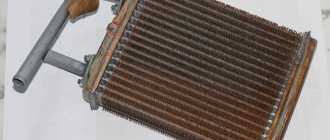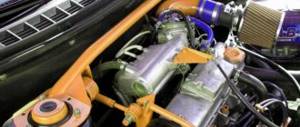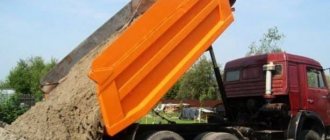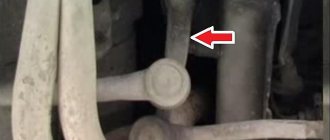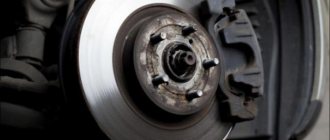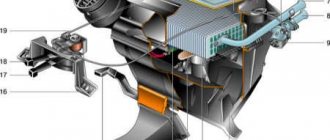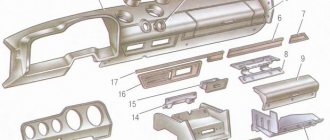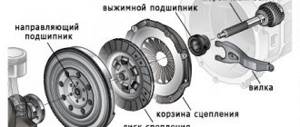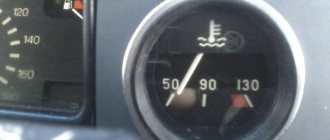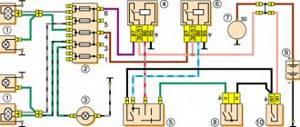The appearance of corrosion, numerous chips, dents and microcracks in the paintwork is not a complete list of problems that owners of VAZ 2106 cars have to face. Despite the complexity of many damages, they are repaired with their own hands.
- Redecorating. The paintwork and bumpers are restored, scratches, chips and areas of corrosion are eliminated.
- Treatment of internal cavities. Spars, sills, door and luggage niches are difficult to access for anti-corrosion treatment. To prevent parts from rusting, they are treated with special protective agents.
- Car underbody treatment. The working surface is covered with special protective mastics.
- Removing dents. To level the dented area, various impact pads, spoons, hooks, suction cups and reverse hammers are used.
- Major body repairs. It is carried out in case of violation of the geometry of the vehicle body, excessive damage to the paintwork, or the presence of a large number of dents, chips and scratches. Also, major repairs are necessary when corrosion has spread to more than 50% of the surface area of the vehicle body.
When carrying out restoration work, the specifics of the car body are taken into account.
Specifics of the VAZ 2106 body
The Lada sixth model has a sedan body type; it consists of a main load-bearing all-metal frame and various attachments. The units and parts that are installed on models from the classic series are made using the stamping method and are connected to each other by welded seams.
The body includes the following parts: engine frame, front fenders, roof, floor panels, left and right side panels. The front and rear bumpers of the car are chrome-plated; they are attached to the body using special brackets. The trunk and hood are quite bulky.
As for the doors, they are made of two panels: outer and inner, they are connected by welding. Both front and rear doors have the same type of attachment to the body.
Six models produced in the mid-90s and early 2000s have thinner body metal compared to cars produced between 1976 and 1990.
Body repair VAZ-2106
A significant advantage was that after many years the body of the “six” did not undergo significant changes. That is why even now repairing this car costs pennies. Any part can be purchased in a store for a reasonable price; in addition to stores, all consumable parts are sold second-hand at any auto repair shop. The most vulnerable parts of the car are the sills, bottom, side members and wheel arches. A major overhaul meant that the fenders and sills would be replaced. Every VAZ owner knew that they needed to be treated with anti-corrosion mastic, for example, Movil for cars. Today the range of Movils is large, but the “six” is unpretentious, even bitumen mastic is suitable for it. This mastic also had a sound-proofing effect, which was necessary for the VAZ body.
This is interesting: Adjusting doors on a Lada Granta - what to do if the front door does not open from the outside: do-it-yourself repairs
When choosing an anti-corrosion lubricant, price is not a determining factor, since the results from both expensive and cheap mastics will be the same. The main thing in this work is not what to lubricate the car body with, but how to do it. If the threshold is in good condition, then you can only get by by pumping mastic into the places where it is necessary; the same should be done with the bottom. The front apron also needs to be treated, since its service life varies from 8 to 9 years. If the apron is in good aesthetic condition, then it favorably emphasizes all the external advantages of this model.
Types of repairs
Do-it-yourself body repair of a VAZ 2106
These works are classified as bodywork:
- Restoration of a standard, factory car body structure. It is noteworthy that when the geometry is shifted, malfunctions in the operation of the machine and an increase in fuel consumption are possible. It becomes extremely difficult to control the vehicle. All this cannot but affect safety: an incorrect body carries danger and preconditions for new accidents;
- Painting. This work is carried out after the body geometry has been restored. It is customary to distinguish between full and partial painting. The last type of work is also called selective painting and involves the treatment of small defects of individual body components;
- Polishing. It is carried out as part of a body restoration program. It is necessary if the lacquer coating has a lot of damage, such as scratches and defects;
- Fighting rust. This means complete treatment of those areas of the car that have already been exposed to corrosion. The body area is cleaned from rust to the metal surface. Special converters are used;
- Fighting dents using special technology. It involves completely straightening areas of the body without damaging the paint. It is noteworthy that after this work there are no traces of restorative manipulations;
- Bumper processing;
VAZ 2106 do-it-yourself body repair
- Thresholds and their repair. The main focus is on the places for the jack;
- Welding works;
- Slip works. In this case, it means restoring the body after an accident using a special unit;
- Straightening, which is the main type of body work.
Is a complete renovation beneficial?
Of course, a complete disassembly of the car with a complete body repair is much more expedient and reliable. However, such work requires significant financial costs. On the other hand, with partial repairs, you may not notice new “sores” that will require body work again in the near future. A complete repair can provide some guarantee that over the coming months, or even years, you will not be tormented by headaches due to the need to treat the body. So, let's take a closer look at a complete car repair. A complete disassembly of the car will be required in order to detect hidden body defects. If we take into account used VAZ cars, they exhibit the following problems:
- Driver's side underbody wear. This section of the bottom is subject to the greatest load and is more likely to corrode.
- Bottom from the luggage compartment side. Again, constant loads lead to rapid wear of the coating and the formation of rust and metal chips.
- Wear of car frame elements.
- Formation of corrosion on arches and sills.
It is not possible to carry out major repairs without welding.
If corrosion has managed to completely destroy the metal parts, you will need to apply patches using welding. It is better to replace severely damaged parts. However, even in this case it will not be possible to do without welding. After welding and other work on the body, the final stage of work will be required - painting.
Tools
To carry out work on restoring the body of the “six”, we will need the following set of tools:
- A set of hammers of different types and weights. Rubber mallets and percussion instruments with a grooved working surface.
- Special hooks.
- Reverse hammers.
- Impact spoons.
- Jack.
- Anvils and substrates of various shapes and sizes.
You should also stock up on 8 and 22 wrenches, as well as a screwdriver. You will need these tools to remove body parts such as bumpers or trim moldings.
Straightening
Tools for straightening the body of a VAZ 2106
It is straightening that should be given more attention if the body of the “six” needs to be given its original appearance.
What does the word "straightening" mean? It is translated as alignment. As mentioned above, body straightening is considered the main work and its goal is to restore deformed areas or the entire body.
Body work in service
Carrying out straightening, as is known, involves a special technique. It is done efficiently and quickly. The goal is to stretch out or straighten concave parts of the body. If the person doing the straightening has little experience, it will be very difficult for him to cope with the work.
On the other hand, thanks to modern technologies, even a beginner can cope with straightening. What does a pneumatic hammer cost, allowing you to quickly bring a body part back to normal.
Common tools for straightening: hammer and jack. Here's how the main stages of straightening are carried out:
- First the paint is removed;
- The area is being straightened;
- The area is puttied and rubbed.
Note. Some experts recommend heating up body parts to make the straightening effect even better. Only in this case it is necessary to control the process, otherwise the metal will overheat and may even melt.
Another secret to straightening: if the dent that needs to be leveled is small, then it is recommended to straighten it from the middle. On the contrary, if the dent is large, it is leveled from the edges.
Straightening dents
In addition to a hammer and a jack, to carry out this operation yourself, you will have to arm yourself with the following tools:
- A spotter used for spot welding;
- Hammers of different types: inertial, reverse and with a sharp striker;
- Notching block.
Recently, it has become popular to carry out vacuum straightening. This procedure allows you to eliminate bruises on a metal surface many times faster. Vacuum straightening is carried out using special suction cups.
Note. This type of straightening is suitable for large dents, but if there are scratches on the surface, this method is not recommended.
Tools used for work
Reverse hammer for body work, used for straightening the body
The tools for body work on the VAZ 2106 are anvils of various configurations, which for the most part correspond to the factory images of the part to be straightened. A body mechanic should have special hammers of various types and weights in his arsenal. Conventional metalworking hammers are not suitable for working on body parts due to the specific design of the working (impact) surface of the tool. If you use a metalworking tool, then under its impact the thin metal of the body is subjected to strong pressure, which causes a decrease in the thickness (thinning) of the surface and its linear expansion, which leads to the formation of new defects. Special straightening hammers differ from metalworking hammers in having a corrugated striking part and are similar to the working plane of a file. In addition, body mechanics in their work range also have hammers with a rubber striking part, which serve to soften the impact.
This is interesting: How to independently perform self-diagnosis of Nissan Primera P12 - step-by-step instructions
Straightening process technology
Complete instructions for body work on the VAZ 2106 can be found here. If the rules for straightening work are correctly followed, the necessary result for the restoration of body parts will be achieved. These rules include the following:
- Anvils should only be used in the appropriate configuration.
- Even when using special straightening hammers, the impact of this tool will cause the metal to change its physical properties, becoming thinner and changing its linear dimensions. Therefore, the blows should be weak but frequent.
- If there are folds on the surface to be repaired, then it is necessary to begin restoring the surface from them, moving towards the center of the defect.
- Every few blows, it is necessary to assess by touch the condition of the metal being restored, check the condition of irregularities and defects, and, taking this into account, adjust the process of working with body metal.
Attention: When restoring large, flat parts of the bodywork, such as the roof, hood and trunk lid, check the product using measuring tools.
Process technology
The VAZ 2106 body is straightened immediately before painting the restored part:
- The surface to be treated is cleaned of dirt, washed, dried and degreased. Remove old paint from the working surface.
- Use frequent gentle blows of a hammer to smooth out the dent. If the defect is deep, then the process is performed from the edge of the damage, and gradually moves towards its center. Metal substrates are placed on the reverse side of the area to be restored. They must have the appropriate shape.
- Metal breaks are repaired using a welding machine. Next, the weld is ground.
- The area restored from damage is covered with putty. It levels the work surface.
- The putty part is sanded and painted.
The putty should be applied in a thin layer. Otherwise, the paint will become covered with numerous cracks and begin to fall off.
Body dimensions of the “six” and their verification
VAZ 2106 geometric dimensions of the body
There is a concept of car body size. Along with this, it is customary to talk about geometric dimensions, which imply control standards and distances, the geometry of door and window openings, the distance between axes and much more.
As a rule, a car that has been in an accident is checked for displacement of the main body elements. Particular attention is paid to the following body parts:
- Diagonals. The car is driven onto the overpass, and then the distance from one extreme point of the floor to the other is checked diagonally using a tape measure. If there is a discrepancy between the distances on one side and the other, there is movement of the body;
- Racks. They are subject to mandatory verification. First of all, if the car has been in an accident, the whole side, not damaged, is diagnosed, and only then the damaged side.
- Roof. To make sure that the roof is not leaking, you need to measure the dimensions of the doorways diagonally. The dimensions, of course, must match on both sides;
- Glass. The conformity of the windshield and rear windows is checked. Both are measured diagonally.
VAZ 2106 control body dimensions
| Body type | Sedan |
| Number of doors | 4 |
| Number of places | 5 |
| Body length, mm | 4116 |
| Body width, mm | 1611 |
| Body height, mm | 1440 |
| Wheelbase, mm | 2424 |
Threshold replacement
The thresholds on the VAZ 2106 during long-term use of the car become covered with rust and, as a result, rot. To replace damaged body elements, perform the following algorithm of actions:
- The doors are removed, the floor mats are removed, and the aluminum trim is dismantled.
- Remove the rusted body element. To do this, use the thresholds, dismantle them using a drill, and cut them out of the fastening with a grinder.
- Clean the work surface from dirt and remove rust.
- Next comes the installation of new thresholds. To do this, weld the connector in place of the dismantled parts.
- After adjusting the elements to size, they are welded to the car body.
- At the end of the work, a trim is attached to the thresholds, it is primed and painted.
When performing repair work to replace thresholds, the trim is washed, corrosion is removed from it, and old paint and primer are removed.
DIY body repair
VAZ 2106 car body
Repairing the outer tail of a car must be taken very seriously, because such repairs are the most expensive, but at the same time it is the most important work on the vehicle. After all, the appearance of a car is directly related to the degree of its grooming. Here, a lot depends on how to carry out this type of repair of the VAZ 2106 body - with your own hands or at a service station. In a broad sense, such body repair is the restoration of paintwork, as well as the original geometry of the body, deformed due to an accident. If there are shallow dents and irregularities on the elements of the body part, repair using the classical method involves treating the damaged area with sandpaper with a fine abrasive, applying putty with a special tool to give the surface a uniform level throughout. But with a dent of small depth, you can use the method of paintless dent removal, photos with application samples posted on our portal. Such work is usually carried out by specialists at a service station. This also applies to sheet metal, welding and other specialized work that should be carried out at a specialized enterprise. Specialists have not only knowledge and skills, but also the necessary software and special tools.
Body Shape Restoration
The car body elements are made by stamping from sheet metal. The tension in the molecular bonds of iron is formed during the extrusion of body elements under a press machine and retains the configuration of the product. When impact is applied to the body tail, which has a convex shape, they are compressed, and then alignment begins, but the tension of the molecular bonds is aimed at maintaining the already changed surface of the body element, already concave in shape. When forming the so-called the molecular tension belt that arose during impact in the damage zone, actions to unload this stress area should be carried out exactly at the place where the defect was formed. It follows from this that when carrying out body repair work, it is enough to clean the paint and primer from the damaged area with a scraper, as well as remove the fold of body metal that has formed on the area of the deformed surface.
Linear dimensions of the body shape of the VAZ 2106
If the defective surface is large in size but shallow in depth, then to level it, blows with a straightening hammer should be applied to the top point of the unevenness. If the defective surface is small but of sufficient depth, then straightening is carried out in parts, starting restoration from the edges of the deformed surface. It is necessary to place an anvil of the desired configuration under the plane being processed. If there are struts or pads in the damaged segment, then these components of the body product are initially restored. The first step in body repair is the restoration of the factory body configuration, which involves 2 main types of body repair - knocking out and straightening. The first type of repair is returning the body to its factory dimensions in a rough version. Here the craftsmen use a wooden mallet in their work so as not to damage the body metal. The next step is straightening. Here it is necessary to work with a hammer even softer in order to prevent linear expansion of the metal.
Attention: If the deformed area is small in size and takes the form of a bubble, then this defect can be eliminated by heating. When the surface cools, the bubble should “dissolve.” It is not recommended to heat such points more than 2-3 times.
Restoring body defects using electric heating
Attention: If it is impossible to use automatic welding in places that are difficult to access, when section elements such as posts, gaskets, etc. are in the deformation zone, a connection such as soldering is used. To do this, the metal surface must be cleaned and the dent filled with tin solder. Excess solder residues are removed and the surface is sanded.
Using automatic welding, you can also carry out restoration by heating the metal and removing dents. This technology is based on the principle of instant heating of a metal surface. A carbon electrode is used for this. Preparatory activities are carried out as usual; it is important to remove the paint, which has insulating properties.
This is interesting: Peugeot 206: Do-it-yourself replacement of spark plugs on a car
